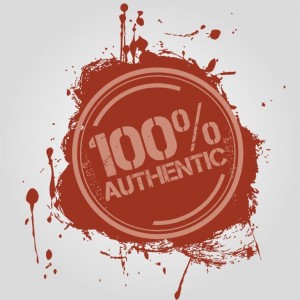 When your brand is perceived to be authentic, your sales increase, your brand loyalty soars, and your competition pales. Authenticity is “truthfulness of origins, attributes, commitments, sincerity, devotion, and intention,” according to Wikipedia. In other words, the real thing! Authentic brands have the attributes of dependability over time. They are not just first to market, but first to satisfy a specific market. They have, in most cases, withstood the test of time. They are the genuine article. They are put on a pedestal, leaders in their niche, and aspired to by their pretenders.
When your brand is perceived to be authentic, your sales increase, your brand loyalty soars, and your competition pales. Authenticity is “truthfulness of origins, attributes, commitments, sincerity, devotion, and intention,” according to Wikipedia. In other words, the real thing! Authentic brands have the attributes of dependability over time. They are not just first to market, but first to satisfy a specific market. They have, in most cases, withstood the test of time. They are the genuine article. They are put on a pedestal, leaders in their niche, and aspired to by their pretenders.
So how does your brand become “Authentic?” Here is our short list:
- Pedigree. It has a name that is synonymous with quality. But unless your brand is Mercedes, Cartier, or Tiffany you’ll have a wait till your brand has a history of performance before you earn those rights. Brand story can also distinguish your brand and give it a desirable unique quality tantamount to pedigree. You can also choose a brand name that describes what it does, some solution it performs, or some description of its niche.
- Original. Your brand was first to satisfy a need. Other subsequent brands in the niche are seen as knock offs. But that’s only true if your brand continues to deliver superior quality. Knock offs will try to exploit the market you have discovered or defined by trying to see how little quality the market will accept and thus undercut your price. Especially in applied technology, being first has an aura of authenticity, but your brand must continue to satisfy an ever-changing unpredictable market.
- Principled. You brand represents high standards for craftsmanship, quality, dependability, customer service, and support for the community. Your company has the reputation of treating its employees, associates, neighbors and the environment with care and respect. You protect this reputation passionately.
- Classic. Your brand’s physical image conveys classic conventions, not just a trendy fad popular at the time and ultimately upstaged by yet another flashy trend. Your brand image, from its logo to its trade dress and from its packaging to its signage, adheres to classic imagery. It’s clear, easy to read and pronounce, easy to remember and identify with, and respects time tested graphic relationships for spacing, color, and quality queues.
- Persona. Like Steve Jobs for Apple, Alexander Graham Bell for Bell Telephone, and Henry Ford for Ford Motor Company, your brand has a real live person behind it. This person represents the brand as if to say, “I guarantee it!” as George Zimmer, former president of Men’s Wearhouse used to say. When there’s a person behind the brand and not just a faceless logo, this adds the credibility that authentic brands require.
There are many more aspects to authenticity but these are the top 5 in our opinion. It’s interesting that when “authentic” brands are acquired they risk losing one or more of these aspects in the name of efficiency, profitability, or standardization. Their authenticity may be taken for granted without appreciation for the subtleties these attributes convey to the market. Authenticity is hard earned and must be vigilantly protected.
But once you your brand earns the reputation of being authentic, your loyal customers will demand it. This is a fantastic advantage in keeping your brand in stock and on page one. Retailers know the power of an authentic brand. They have to carry it if they want to attract the brand’s loyal following. They have to keep it in stock to please their customers and save their own reputation.
There’s nothing like the Real McCoy. Why not build some authenticity into your Brand?

